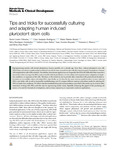Mostrar o rexistro simple do ítem
Tips and Tricks for Successfully Culturing and Adapting Human Induced Pluripotent Stem Cells [Protocol]
| dc.contributor.author | Castro Viñuelas, Rocío | |
| dc.contributor.author | Sanjurjo-Rodríguez, Clara | |
| dc.contributor.author | Piñeiro-Ramil, María | |
| dc.contributor.author | Rodríguez-Fernández, Silvia | |
| dc.contributor.author | López-Baltar, Isidoro | |
| dc.contributor.author | Fuentes Boquete, Isaac Manuel | |
| dc.contributor.author | Blanco García, Francisco J | |
| dc.contributor.author | Díaz-Prado, Silvia | |
| dc.date.accessioned | 2021-12-07T08:07:21Z | |
| dc.date.available | 2021-12-07T08:07:21Z | |
| dc.date.issued | 2021-12 | |
| dc.identifier.citation | Castro-Viñuelas R, Sanjurjo-Rodríguez C, Piñeiro-Ramil M, Rodríguez-Fernández S, López-Baltar I, Fuentes-Boquete I, et al. Tips and tricks for successfully culturing and adapting human induced pluripotent stem cells. Mol Ther Methods Clin Dev. 2021;23:569-581 | es_ES |
| dc.identifier.issn | 2329-0501 | |
| dc.identifier.uri | http://hdl.handle.net/2183/29076 | |
| dc.description | Protocol | es_ES |
| dc.description.abstract | [Abstract] Reprogramming somatic cells toward pluripotency became possible over a decade ago. Since then, induced pluripotent stem cells (iPSCs) have served as a versatile and powerful tool not only for basic research but also with the long-term goal of using them in human cell transplantation after differentiation. Nonetheless, downstream applications are frequently blurred by the difficulties that researchers have to face when working with iPSCs, such as trouble with clonal selection, in vitro culture and cryopreservation, adaptation to feeder-free conditions, or expansion of the cells. Therefore, in this article we aim to provide other researchers with practical and detailed information to successfully culture and adapt iPSCs. Specifically, we (1) describe the most common problems when in-vitro culturing iPSCs onto feeder cells as well as its possible troubleshooting, and (2) compare different matrices and culture media for adapting the iPSCs to feeder-free conditions. We believe that the troubleshooting and recommendations provided in this article can be of use to other researchers working with iPSCs and who may be experiencing similar issues, hopefully enhancing the appeal of this promising cell source to be used for biomedical investigations, such as tissue engineering or regenerative medicine applications. | es_ES |
| dc.description.sponsorship | We thank the laboratory staff from INIBIC-CHUAC, the Radio Physics department from the Oncology Center of Galicia and the Servicio de Xenética (CHUAC) for their assistance. We also thank the staff from Oza University Library (University of A Coruña) for their collaboration. We also thank our funding agencies: Instituto de Salud Carlos III-General Subdirection of Assessment and Promotion of the Research—European Regional Development Fund (FEDER) “A way of making Europe” (PI17/02197 and PI20/00933); Rede Galega deTerapia Celular and Grupos con Potencial de Crecemento, Xunta de Galicia (R2016/036, R2014/050, CN2012/142, ED431B 2020/55, and GPC2014/048); the University of A Coruña; M.P.-R. and S.R.-F. are granted by a predoctoral fellowship from Xunta de Galicia and European Union (European Social Fund) and C.S.-R. was beneficiary of a postdoctoral fellowship from Xunta de Galicia | es_ES |
| dc.description.sponsorship | Xunta de Galicia; R2016/036 | es_ES |
| dc.description.sponsorship | Xunta de Galicia; R2014/050 | es_ES |
| dc.description.sponsorship | Xunta de Galicia; CN2012/142 | es_ES |
| dc.description.sponsorship | Xunta de Galicia; ED431B 2020/55 | es_ES |
| dc.description.sponsorship | Xunta de Galicia; GPC2014/048 | es_ES |
| dc.language.iso | eng | es_ES |
| dc.publisher | Cell Press | es_ES |
| dc.relation | info:eu-repo/grantAgreement/MICINN/Plan Estatal de Investigación Científica y Técnica y de Innovación 2017-2020/PI20%2F00933/ES/Vesículas Extracelulares Pequeñas (sEVs): una nueva herramienta terapéutica para el tratamiento de la artrosis/ | |
| dc.relation | info:eu-repo/grantAgreement/MINECO/Plan Estatal de Investigación Científica y Técnica y de Innovación 2017-2020/PI17%2F02197/ES/Células madre pluripotentes inducidas (iPS) como modelo de artrosis de manos/ | |
| dc.relation.uri | https://doi.org/10.1016/j.omtm.2021.10.013 | es_ES |
| dc.rights | Creative Commons Attribution 4.0 International Licence (CC-BY 4.0) | es_ES |
| dc.rights.uri | http://creativecommons.org/licenses/by/4.0/ | * |
| dc.subject | iPSCs | es_ES |
| dc.subject | Feeders | es_ES |
| dc.subject | Feeder-free | es_ES |
| dc.subject | Culture | es_ES |
| dc.subject | Trobleshooting | es_ES |
| dc.subject | Tips and tricks | es_ES |
| dc.subject | Protocols | es_ES |
| dc.subject | Cryopreservation | es_ES |
| dc.subject | Irradiation | es_ES |
| dc.title | Tips and Tricks for Successfully Culturing and Adapting Human Induced Pluripotent Stem Cells [Protocol] | es_ES |
| dc.type | info:eu-repo/semantics/article | es_ES |
| dc.rights.access | info:eu-repo/semantics/openAccess | es_ES |
| UDC.journalTitle | Molecular Therapy Methods & Clinical Development | es_ES |
| UDC.volume | 23 | es_ES |
| UDC.startPage | 569 | es_ES |
| UDC.endPage | 581 | es_ES |
| dc.identifier.doi | 10.1016/j.omtm.2021.10.013 |
Ficheiros no ítem
Este ítem aparece na(s) seguinte(s) colección(s)
-
GI-TCMR - Artigos [129]
-
INIBIC-TCMR - Artigos [102]
-
INIBIC- REUMA - Artigos [184]






